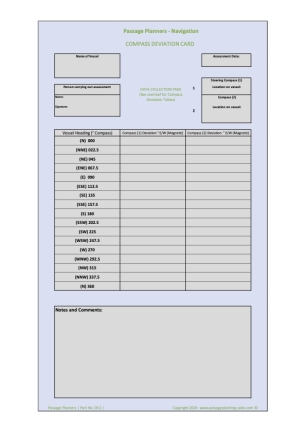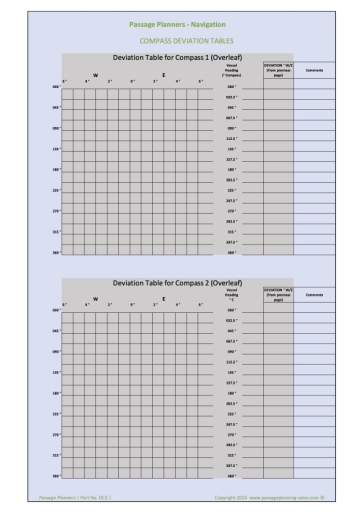Swinging your boat compass
Here is our form as detailed below which enables you to enter data from readings observed in swinging the magnetic compass of your yacht or other vessel.
The compass in question will generally be your steering compass which will normally be situated at your steering position.
There are many articles to be seen on line which describe the procedure, both in written articles and also videos.
We have found a useful article by Practical Boat Owner on the subject. This article can be accessed from our Links page. (opens in new tab).
You can do it yourself. It isn't difficult. The objective is to determine “Deviation”, which is the difference between magnetic bearings and the actual bearing you read on your boat.
First find something that will give you a good true bearing. That probably means finding a “range”. You need to look at your local chart and find two structures that line up. This might be a church steeple and the corner of a building. Or Pilot books and local charts may list leading marks and often give their bearing towards the land in degrees true (°T).
Just do the best you can to get a bearing on the range for a variety of headings. Get readings for all around the compass.
Convert the true bearing of the range to “Magnetic” by applying “Variation”, which can be found on the compass rose on a chart local to your location. This means adding West Variation (or subtracting East Variation) to or from the true (True) bearing to get Magnetic.
Use our Deviation Card to make a table of all your actual bearings and compare them to the Magnetic bearing. Label the difference as E or W based on the above rule.
Plot your deviation readings onto the Deviation Chart and draw a curve of all the points made such that you can see your compass deviation throughout your compass range.
Smooth out the readings, assuming you didn't do perfect bearings. Eliminate those that are off the trend as the bearings change. You now have Deviation and you can apply to your heading.
Although it is not difficult to swing a compass, much depends on the sea and weather conditions at the time and, to be quite frank, we found that the most efficient way to cover this was to employ a professional for a few hours. Agreed, it does cost, but not
silly money and you have the satisfaction that it has been carried out professionally.
However this is just our opinion and you should not shy away from carrying out the procedure yourself and, indeed should be encouraged. The PBO article says, unless the errors are great and in excess of, say 7-8 degrees, then it may be ok to leave it. However we disagree with this and consider it too excessive. For most sailors, having deviation in your main compass may not generally affect you, outside of longer voyages. Nevertheless from an accuracy point of view it is always good to know that your compass has been checked for deviation and that you have been able to make a deviation card to represent the compass deviation throughout the compass rose. For this reason we encourage you to go swing your compass!


Passage Planners Compass Deviation Card
This takes the form of two pages.
Page 1 (data collection) details your boat, the date of the compass swinging and the person carrying out the procedure. Additionally it allows for 2 compasses to be swung i.e your main steering compass plus an additional compass. This card records the deviation noted at each of the compass points shown at the left of the card.
Page 2 (deviation table) on the reverse allows you to chart each of the results from page 1 from which you are then able to “join the dots” in order to draw the line of the compass deviation for the compass in question.
We offer our Compass Deviation Card as a set of two A4 size plastic heat encapsulated forms (Supplied as 2 A4 size pages in 1 encapsulated pouch) which will enable you to record the data observed from your compass swinging and to then draw a graph of the magnetic deviation of your vessel’s compass.
Waterproof and supplied in Matt finish both sides, each form can be written on using a B grade pencil and easily erased with a rubber eraser. Can be used several times. (Supplied as 2 A4 size pages in 1 encapsulated pouch part: DC12).
We also provide a sample Deviation Card with suitable data filled in to further demonstrate how the card works.
Click here to purchase our Compass Deviation Card
(Opens in new tab)


